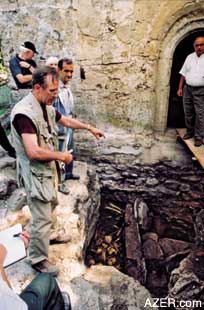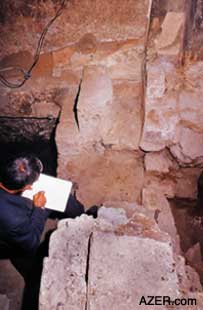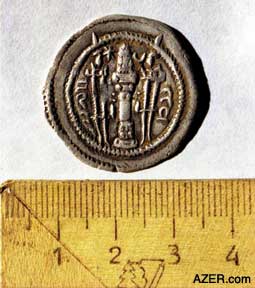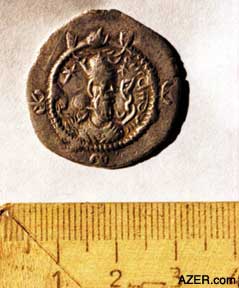|

Spring 2003 (11.1)
Pages
33-39
The Church in Kish
Carbon
Dating Reveals its True Age
by J. Bjornar Storfjell,
Ph.D
Other articles
by or related to Bjornar Storfjell:
Thor
Heyerdahl's Final Projects - Bjornar Storfjel (AI 10.2, Summer
2002)
Voices
of the Ancients: Rare Caucasus Albanian Text - Zaza Alexidze
(AI 10.2, Summer 2002)
The Kish Church:
Digging Up History - Bjornar Storfjell (AI 8.4, Winter 2000)
An interview with J. Bjornar Storfjell
  When archaeologists come upon discoveries
hidden in the earth, it often takes time to research and make
comparative studies in order to truly comprehend them. At first
glance, for example, they can identify a piece of pottery, but
it may take months or even years of further research to fully
appreciate its significance. When archaeologists come upon discoveries
hidden in the earth, it often takes time to research and make
comparative studies in order to truly comprehend them. At first
glance, for example, they can identify a piece of pottery, but
it may take months or even years of further research to fully
appreciate its significance.
The same holds true for the Kish Church Project near Shaki in
Northwestern Azerbaijan, a project that was undertaken so that
the architecture could be restored. In the meantime, the archaeological
knowledge gained is helping fill in some of the blanks related
to the development and spread of Christianity via Albanian Caucasian
churches.
The archaeological dig at the Kish church took place in the summer
of 2000. In August, the results of carbon-14 dating on four samples
were made available. Now, nearly three years later, scientists
have had a chance to do some comparative studies. The results
are somewhat different than expected. The church building, as
it turns out, was built more recently than previously thought.
Instead of being erected in the 5th or 6th century, Carbon-14
dating places it very likely in the 12th century (990-1160 A.D).
In addition, the church building itself was discovered to have
undergone architectural alterations that reflect theological
shifts, brought about by the geopolitical realities of the day.
For example, the belief in the nature of Christ (whether he was
fully man and / or fully God) is reflected in the height of the
floor of the area in the church (the chancel) where the priest
officiates in relationship to where the congregation stands.
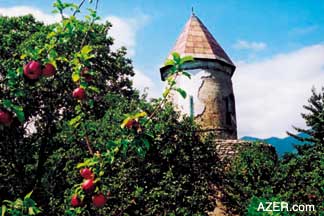  Left: Kish Church near the town of Shaki
in the Caucasus. Archaeological work was done to determine its
age before reconstruction work began. (Photo by Bjornar Storfjell) Left: Kish Church near the town of Shaki
in the Caucasus. Archaeological work was done to determine its
age before reconstruction work began. (Photo by Bjornar Storfjell)
Also the archaeological
dig at Kish revealed evidence of the Early Bronze Age culture
known as the Kur-Araz culture, which originated in the Caucasus
region about 3500 B.C. This culture is known to have spread both
northward as well as southward across Anatolia as far as Syria,
Israel and Palestine, and possibly even to Egypt.
But more significantly, the site on which the church was built
suggests that prior to Christianity, it was a cult site that
dates back 5,000 years (3,000 years prior to the beginning of
Christianity). The fact that this site was used for earlier belief
systems is not an unusual phenomenon for sacred sites throughout
the world.
We've written about the Kish project before when we interviewed
archaeologist Bjørnar Storfjell in the summer of 2000
and featured him in an article in our winter issue that year,
"The Kish Church, Digging Up History." Search at AZER.com.
Now that the results are back from carbon dating, new interpretations
can be made.
The Kish Church
Actually, you have to go quite a distance out of your way even
to find the place. From Baku, Azerbaijan's capital, on the western
seacoast of the Caspian, you drive about five hours northwest
to the charming, picturesque city of Shaki, located in the foothills
of the Caucasus Mountains. From there, the Kish village is about
five km further north on a poorly marked road with broken pavement.
It takes some maneuvering to manage all the ruts. The small village
is located about 1,200 meters (3,600 feet) above sea level on
a small ridge between two branches of the Kishchay (Kish River).
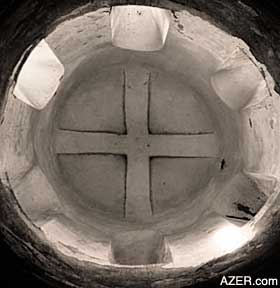  Left: Interior view of the dome of the Kish
Church. Archaeologists date the original construction of the
church to around the11th or 12th century. (Photo by Bjornar Storfjell) Left: Interior view of the dome of the Kish
Church. Archaeologists date the original construction of the
church to around the11th or 12th century. (Photo by Bjornar Storfjell)
In general, the village
is rather non-descript, with its houses constructed of gray river
stones. The dull color, however, beguiles the nature of the people
who are really quite hospitable and cheerful.
Similar to many small mountain villages, agriculture and animal
husbandry comprise the backbone of the local economy, but many
of the villagers try to supplement their income with work in
Shaki. In the summer of 2000, the only obvious employment in
the village was the construction of a new mosque.
The Kish church sits on a relatively large plot of land, especially
given its own small physical size.
In fact, the building is actually taller than it is wide. No
homes are built close by. The church itself is really small and
spartan in both its architectural design and detail. In North
Syria, there are more than a hundred churches that bear close
resemblance to this one in Kish that were constructed between
the 4th and 7th centuries and that are found in the smallest
of hamlets and villages. You probably can't fit more than 25-50
people inside them - and that's with everybody standing, as was
the custom of the day. Churches didn't have seats or pews back
then. In Azerbaijan, there are a number of Christian churches
much larger and much older than this one in Kish.
The idea for the Kish Project originated with Bjørn Wegge
of Norwegian Humanitarian Enterprise of Oslo, who himself had
done graduate work in Early Church History in the Eastern Church.
His cultural interests coincided with those of Olav Berstad,
who was the Norwegian Ambassador to Baku at the time. Berstad
himself had been professionally trained as an archaeologist.
Between the two of them, the concept for the project soon took
on a life of its own. Berstad felt that the more the newly independent
nation of Azerbaijan could establish direct links with its past,
the more Azerbaijan would be able to strengthen its national
identity as a separate entity in the Caucasus.
Below: Left and Right: Storfjell consulting
at excavations at the Kish Church.
The idea was to restore the
Kish church architecturally and convert it into a museum, which
would then be dedicated to the early church history of Caucasus
Albania - the region that now is known as Azerbaijan. The project
developed into a joint Azerbaijani-Norwegian effort under the
direction of Dr. Gulchohra Mammadova, Rector of the University
for Architecture and Construction and a Member of Parliament.
However, before reconstruction was to begin, archaeologists were
consulted to try to establish the date of the church and determine
if there had been any early stages of construction or use. Dr.
Vilayat Karimov of Baku's Institute of Archaeology and Ethnography
served as the Director of Excavations. Archaeologists included
Aliya Garahmadova of the same institute, Suseela C. Y. Storfjell
of the University of Sheffield, England. I served as archaeological
advisor for the project. The actual archaeological dig was carried
out in two sessions: June 5 - July 3, 2000, and then two months
later from September 4-13.
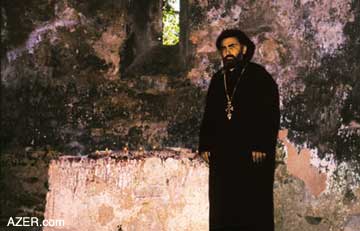  Left: The Georgian priest who came to conduct
a service at the Kish church while the archaeologists were excavating.
It seems this may have been a long-standing tradition, even though
there were no parishioners. (Photo by Bjornar Storfjell) Left: The Georgian priest who came to conduct
a service at the Kish church while the archaeologists were excavating.
It seems this may have been a long-standing tradition, even though
there were no parishioners. (Photo by Bjornar Storfjell)
Archaeological excavation
was concentrated mostly inside the church, although a few trenches
were dug outside along the north and east side of the apse (the
rounded end of the church) [see sketch]. Other trenches were
opened in front of the church entrance on the west end and along
the south and southwest sides.
Inside the church, we began our investigation along the north
wall just in front of the chancel steps (the raised platform
area where the priests officiate). We soon discovered, however,
that we were not the first to carry out some excavation there.
After digging down about 1.5 meters, we were surprised to come
upon an artifact of quite modern origin - namely, a size D battery
manufactured in Japan. It was clear evidence of a spent flashlight
of recent date, and the unmistakable traces of treasure hunters
- either robbers or bootleg archaeologists! We asked the villagers
if they knew of anyone who might have been digging around in
the church, but no one seemed to have any knowledge of it. Nor
did anyone at Baku's Institute of Archaeology and Ethnography,
the institution responsible for coordinating all archaeological
activity throughout the country.
Of course, on sunny days, the diggers would not have needed any
artificial light to dig inside the church. However since they
were tunneling under the chancel floor, they obviously needed
light to see what they were doing, as the trench was about four
meters long (12 feet), much of it under the flooring. They had
dug to a considerable depth below the foundation of the church,
well into what archaeologists term "sterile soil,"
meaning soil that has not been modified from its original state.
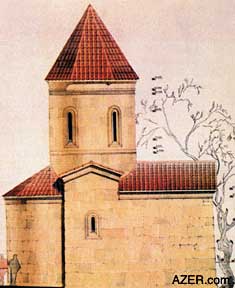  Left: Architectural
rendering of Kish Church. (Photo by Gulchohra Mammadova) Left: Architectural
rendering of Kish Church. (Photo by Gulchohra Mammadova)
Then the culprits had
refilled the trench. However, when it comes to archaeological
investigation, such cover-up work can easily be detected, even
if the soil has been packed down very hard, which it hadn't been.
During the weeks that followed, our imaginations worked overtime
trying to think who might have intruded. Soon our speculations
became a source of tales and jokes that lightened the grind of
everyday excavation work. In the end, we never did learn who
had been digging there. Oh, if only walls had eyes to see and
tongues to speak!
We were quite eager to begin excavation in the northern half
of the apse. To do so meant that the altar would have to be dismantled.
But then a Georgian priest appeared on the scene, wanting to
perform a liturgy. After all, he was just carrying on the intended
use for the church, despite the fact that there were no parishioners.
He only came once while we were working there. We explained to
him what the duration of the project would be, both in regard
to excavation, as well as to its architectural restoration. If
he had been in the habit of stopping by more frequently at the
church, we were not aware of it. He seemed pleased to learn about
the restoration work.
And so the priest conducted a brief liturgical service while
we stood there in silent reverence of that sacred moment in time.
The darkness inside the church was accentuated only by a few
rays of sun penetrating through the slits in the cupola. There
in the darkness, the clergy's face was illuminated by candle
flame. His voice echoed through the stone vaulted interior of
the old stone structure. It didn't seem to matter that his words
were unintelligible to us; they still had the power to transport
us back to a different era in time.
Soon afterward, we got back to work, excavating the altar to
see what might lie beneath it. Archaeology requires that whenever
any monument is dismantled that it should first be carefully
recorded and photographed as it originally stands. In this case,
the plaster was carefully removed so that the stones could be
numbered, a process that would facilitate its reassembly.
Below: right and left: A coin from the 6th
century, featuring Sasanian King Kavad I was found in the excavation
of the Kish church. (Photos
by Bjornar Storfjell)
Generally, archaeologists can
expect to find a reliquary (a box with a relic that relates closely
to the person or the saint) buried underneath the church altar,
especially if the place of worship has been named or dedicated
after an individual or a saint. We found no such evidence at
Kish. Instead, beneath the altar lay irrefutable evidence of
an Early Bronze cultic sacrificial pit, yielding secrets of ceramic
fragments, charcoal, charred bones and two skulls of sheep or
goats. The carbon dating eventually yielded up the secrets of
the pit, dating the contents to around 3000 B.C.
Kur-Araz Pottery
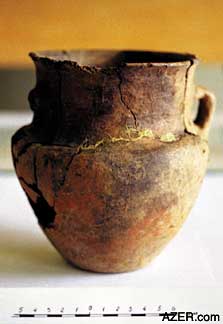  Left: A sample of Kur-Araz pottery that dates
to the 3rd century B.C. was found underneath the altar of the
church and suggested the site had been used as a cult site 5,000
years ago. (Photo by Bjornar
Storfjell) Left: A sample of Kur-Araz pottery that dates
to the 3rd century B.C. was found underneath the altar of the
church and suggested the site had been used as a cult site 5,000
years ago. (Photo by Bjornar
Storfjell)
Our first clues that
something was buried under the altar came when we realized that
the soil in the pit had a different color and texture. Near the
bottom of the pit, we came across some ceramic fragments buried
in the dark, ash-like soil.
After the ceramic fragments had been cleaned and reassembled,
we identified it as a small jar that belonged to what archaeologists
call the Kur-Araz culture [Kura-Araxes in Russian]. It was handmade,
not turned on a potter's wheel. Its base was smaller than the
opening of the jar. This term Kur-Araz in archaeology designates
the culture in the watershed region of these two rivers in the
Caucasus that dates back to the 4th and 3rd millennia B.C.
In the Eastern Mediterranean world, these same ceramic forms
that originated in the Caucasus and showed up later in the 3rd
millennium B.C. are known as Khirbet Kerak Ware, having been
named after the archaeological site on the southwestern shore
of the Sea of Galilee in Israel, where they were first discovered
in the 1960s. Such ancient pottery found in countries quite distant
from the Caucasus such as Syria, Lebanon, Israel and (Amiran
1969: 68-69) is recognized as a foreign cultural phenomenon,
with no local roots. Much more research is needed to trace the
stages of this cultural migration of ceramic forms from the Caucasus
southward into Iran and southwesterly through Anatolia and along
the Eastern Mediterranean coastline.
This same Kur-Araz culture also migrated north of the Caucasus
and was found in the Guba (Kuba via the Russian language) region
and also in Dagestan of Southern Russia (Kushnareva 1997:44).
It appears that in the Early Bronze period, in the 4th and 3rd
millennia B.C., the Caucasus (Trans-Caucasus via Russian) was
the cradle of a culture that spread in all directions. More research
is needed to understand the development of this cultural diffusion.
Sixth-Century Coin
We also found other artifacts. For example, a silver coin was
found near the northeast corner of the apse. Unfortunately, it
was not recorded and photographed in situ, that is, in the very
spot where it had been found. Since it had been removed from
its immediate stratigraphic context before being recorded, the
coin provided less archaeological value than might have been
possible otherwise. The coin was quite legible, both on the obverse,
as well as the reverse, side. We sent a photo to Dr. Vesta Sarkhosh
Curtis, Curator of Parthian and Sasanian Coins at the British
Museum, who confirmed that the coin was a silver drachma featuring
Sasanian King Kavad I, who ruled from 488-496 A.D. and again
from 498-531 A.D. She figured out that the coin belonged to the
second period of Kavad's rule because the regnal year on the
left side of the reverse reads 39. The mint legend on the right
side of the Zoroastrian fire altar is Istakhr, a town about 5
km north of Persepolis in southwest Iran. The Pahlavi/Middle
Persian legend on the obverse reads "Kavad Apzud",
literally "Kavad Increase," or meaning "May the
Glory of Kavad Increase."
Below: (two photos)In a burial at the entrance
of Kish church were various artifacts, dating back to the 13th
century, including a small cross made of mother-of-pearl and
numerous strands of gilded thread, possibly from clerical robes
and an embossed gold piece, possibly from a belt or sash used
in clerical attire. (Photos
by Bjornar Storfjell)
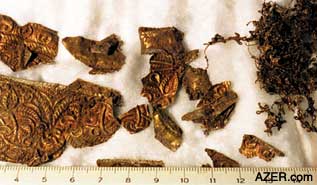  If it could be ascertained that the
coin had come from the construction phase of the church, it still
would only have provided us with the earliest possible date for
construction. In reality, coins and their mint dates are not
the best indicators of the age of the soil layer in which they
were found. In a study that I carried out with James Brower in
the early 1980s, we showed that coins are reliable for dating
only about 40 per cent of the time (Storfjell and Brower 1982). If it could be ascertained that the
coin had come from the construction phase of the church, it still
would only have provided us with the earliest possible date for
construction. In reality, coins and their mint dates are not
the best indicators of the age of the soil layer in which they
were found. In a study that I carried out with James Brower in
the early 1980s, we showed that coins are reliable for dating
only about 40 per cent of the time (Storfjell and Brower 1982).
That means you would have a greater chance of being correct by
simply flipping the coin. At least then you would have a 50-50
chance of being right! It is, however, fairly safe to conclude
that someone had been in the Kish area perhaps in the sixth century
or early seventh century and had simply lost the coin. Again
it must be stressed that the very limited scope of our excavations
leaves us with so many unanswered questions as to who that person
might have been and what kind of activities might have been carried
out in Kish at that time.
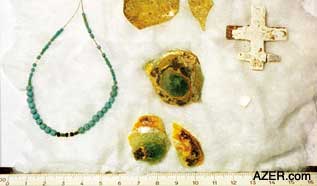  In all, we organized four specimens
to be tested for Carbon-14 analysis at the Beta Analytic in Miami,
Florida that August 2000. One sample was taken from the charcoal
found in the pit. Since the charcoal came from the ash-like soil
that was found among the charred bones and the broken ceramic
jars, we assumed it might provide a likely date that would identify
the period of the cult sacrifice and the pottery. In all, we organized four specimens
to be tested for Carbon-14 analysis at the Beta Analytic in Miami,
Florida that August 2000. One sample was taken from the charcoal
found in the pit. Since the charcoal came from the ash-like soil
that was found among the charred bones and the broken ceramic
jars, we assumed it might provide a likely date that would identify
the period of the cult sacrifice and the pottery.
When collecting samples for carbon dating, it is necessary to
use extreme caution since false readings can occur in the process
if the specimens are contaminated. For example, since this form
of testing is based on the decay of carbon radioactivity, samples
cannot be wrapped in any type of organic material, such as plastic,
which is an oil derivative, meaning that as it was made of a
petroleum product it contains radiocarbon itself. So we wrapped
the four samples that we wanted to test - bone, charcoal and
two soil samples - in a mineral derivative-aluminum foil - and
placed them in bottles that had caps separating the plastic with
tinfoil.
We organized for the samples to be taken from the site early
one morning when we began excavation. People had been told the
day before that we would be gathering the samples, since no one
would even be permitted to smoke when we extracted them. Nor
did we touch the samples with our hands, but rather coaxed them
into the containers using the metal tip of the trowels.
  Left: Dr. Vilayat Karimov of Baku's Institute of Archaeology
and Ethnography served as the Director of Excavations. Here he
points to pottery shards that were identified as Kur-Araz pottery
of the 3rd century B.C. (Photo by Bjornar
Storfjell) Left: Dr. Vilayat Karimov of Baku's Institute of Archaeology
and Ethnography served as the Director of Excavations. Here he
points to pottery shards that were identified as Kur-Araz pottery
of the 3rd century B.C. (Photo by Bjornar
Storfjell)
The radiocarbon analysis
on the charcoal in the pit beneath the altar was 4500±40B.P.
(Beta-157479) with a 13C to 12C ratio of -23.7. The 2s calibrated
result representing historical dates was 3360 to 3030 B.C. with
a 95% probability. This analysis thus corroborates the ceramic
analysis that we would make, lending strong support for the pit
dating back to the Early Bronze Age (circa 3000 B.C.).
This meant that already three millennia before Christianity was
founded, the site upon which the Kish church would be built,
was being used for sacrifices - as a cult site. Actually, it
is quite a common phenomenon that cult sites, where sacred rituals
previously were carried out, often retain their sacredness, even
though religious form and content may change through the ages.
Thus, many churches throughout the world, not just the Kish Church,
have been built on the remains of earlier sacred sites.
Because of the limited scope of our excavation at Kish, we unfortunately
have no further archaeological evidence to understand what might
have been going on there during that era. This intriguing question
awaits further archaeological work in the village.
Floor Level
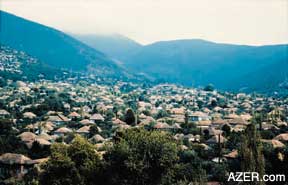  Left: The town of Shaki lies in the foothills
of the Caucasus about five hours northwest of Baku. Kish is a
village about 5 km distance further up in the mountains. (Photo
by Oleg Litvin) Left: The town of Shaki lies in the foothills
of the Caucasus about five hours northwest of Baku. Kish is a
village about 5 km distance further up in the mountains. (Photo
by Oleg Litvin)
We also suspected that
excavating the chancel area might give us a clearer picture of
the various phases that the church might have been used for over
the centuries. This turned out to be the case: alteration of
the level of the flooring, indeed, was evident and indicated
a modification in theological belief.
In the nave, we discovered that the church represented two different
periods of use, with two different corresponding floor levels.
From the apse we know that when the church was first built, the
floor in the chancel was only between 30 and 40 cm above the
level of the floor of the nave. Later it would be raised to about
one meter (100 cm) above the floor of the nave.
What is of interest is the presence of two significantly different
levels for the floor in the chancel. In the Eastern Church, the
theological debate concerning the nature of Christ raged on between
the 4th and 5th centuries and was not officially put to rest
until the Council of Chalcedon in 451 A.D. Later various national
churches aligned themselves with one position or the other. The
question that concerned them dealt with the nature of Christ
- his deity and his humanity: Was Christ only divine, but manifest
in human form, or was He fully divine and fully human at the
same time? In church history, this debate came to be known as
the monophysite vs. diophysite struggle (one nature vs. two natures).
In churches that reflect a belief in Christ as being diophysite
- the floor level between the chancel where the priest officiates
and where the worshippers stand is closer. In other words, the
priest, who is Christ's representative on earth, is in closer
proximity to the worshippers. This idea reflects the belief that
Christ was God but also fully human. In contrast, in churches
holding onto the monophysite belief, the chancel is built at
a higher elevation.
In the Caucasus, three national churches arose during this period,
and in the debate related to the nature of Christ, only the Georgian
Church followed Constantinople [Istanbul] and the Council of
Chalcedon, which settled the Christological debate by pronouncing
in favor of the dual nature of Christ - the diophysite position
(Ferguson 1997:233). There seems to be some evidence that the
Caucasus Albanian Church also remained within the diophysite
tradition but only until early in the eighth century (Alexidze
2002:27). After that time, the monophysite doctrine prevailed
in both the Armenian Church and the Caucasus Albanian Church
(Lerner 1999: 212 and Di Berardino 1992:18).
Since the architecture of the apse of the original church in
Kish suggests a diophysite Christology, and since the Georgian
Church was the only diophysite church existing in the Caucasus
in the late medieval period, it seems reasonable to suggest that
the Kish church was built as a Georgian church and was later
taken over by monophysites. The remaining three radiocarbon dates
also seem to favor such an interpretation.
Charcoal Sample
We chose the second sample for carbon dating from some charcoal
taken from the lowest soil layer in the nave. Since there was
only sterile soil below this sample, it would represent the time
period of the construction of the original church, when the area
would have been cleared for that purpose. The result of the analysis
of the sample was 980±40B.P. (Beta-157480) and the 13C
to 12C ratio was - 25.3. The 2s calibrated result representing
historical dates was 990 to 1160 A.D. with a 95% probability.
Bone Samples
The other two samples were bone fragments from two burials that
relate to the construction of the church. Outside the church
on the eastern side of the building, we found a series of burials.
Curiously, the lowest burial in this sequence had caused the
builders of the church to make a small niche at the very bottom
of the foundation wall for the apse, no more than about 20 cm.
deep, to accommodate the skull of the burial. In digging the
trench for the foundation, the builders had come upon this burial,
and not wanting to disturb it, had made a small indentation in
the base of the foundation so the head in the burial would not
be disturbed.
The burial orientation with the head to the west and the feet
to the east, leads us to assume that the burial was Christian.
Its relationship to the foundation wall suggests that it was
already there when the church was built. The result of this sample
was 1000±40B.P. (Beta-157482) and the 13C to 12C ratio
was -19.1. The 2s calibrated results representing historical
dates were A.D. 980 to 1060 and A.D. 1080 to 1150 with a 95%
probability. In this situation the first set of dates, A.D. 980
to 1060, represent the better curve, since the 1sigma limits
fall within those dates, while the second set represents a "shadow."
Thus the first set of dates is the one preferred.
That would seem to suggest that the burial could have been nearly
a century earlier than when the church was built, possibly early
in the 12th century. Again, historically this fits very well.
It was during the expansion of Georgia under the rule of King
David the Builder (1089-1125 A.D.), when nearly all of the territory
from the Caspian Sea to the Black Sea was under Georgian influence
(Alexidze, October 11, 2001 and Allen 1971:96-100). Thus, the
architectural elements that reflect theology point to a Georgian
church. Chronologically, the radiocarbon dates do the same.
Dr. Zaza Alexidze of the Kekelidze Institute of Manuscripts of
the Georgian Academy of Sciences in Tbilisi, Georgia informs
us that the general area of Kish remained under Georgian suzerainty
until the 17th century, when the Persian Shah Abbas wrestled
it from Georgia and established the "Sultanate of Elis"
(Alexidze, October 11, 2001).
Theological Questions
It is probably quite safe to assume that it was the diophysite
theology of the Georgian Church that was followed and reflected
in the architecture in Kish, since the area was under Georgian
political control. It would probably also be safe to assume that
as soon as Georgia no longer controlled the region, the Caucasus
Albanian Church, which since the eighth century, and possibly
earlier, had adopted a monophysite theology like the Armenian
Church, would make its theological position felt in regards to
the height of the chancel in the church.
We can then conclude that the remodeling of the church, elevating
the chancel from between 30 to 40 cm above the floor in the nave
to nearly 1 meter above the floor, took place sometime in the
17th century. Also, after the small enlargement of the chancel
area, the church remained a monophysite place of worship until
it ceased to be an active church in the 19th century. Perhaps,
this even explains the tradition of the visit by the Georgian
priest to conduct services despite the fact that he had no parishioners.
Therefore, the medieval literary tradition concerning the church
in Kish (and earlier oral tradition which cannot be verified),
repeated by several present-day scholars (Mammadova 2002: 34,
35, 38), cannot be given serious consideration. This tradition
suggests that the Kish Church was built at the end of the first
century A.D. If true, that would indeed make this a truly significant
church, since no church structures anywhere in the world are
known to have been constructed earlier than the mid- to late-third
century (Meyers 1997:1). To refer to the Kish church as the "Church
of St. Eliseus" (Mammadova 2002) is to attempt to give scholarly
credence to a medieval literary tradition whose date cannot be
substantiated and supported by archaeological evidence.
The fourth sample for carbon dating was a bone taken from a tomb
under the entrance to the church. The radiocarbon analysis gave
a result of 700±40B.P. (Beta-157481) with a 13C to 12C
ratio of -18.8 . The 2s calibrated results representing historical
dates were 1260 to 1310 A.D. and 1360 to 1390 A.D. with a 95%
probability. This situation is the same as the one encountered
with Beta-157482 and, therefore, the preferred dates are 1260
A.D. to 1310.
A mended glazed ceramic bowl from this tomb also suggests a late
medieval date. Other items in the grave clearly were related
to some high-ranking clergy in the early years after the construction
of the church. These finds consisted of a small cross made of
mother-of-pearl and numerous strands of gilded thread, which
very likely came from his clerical robes. There was also an embossed
gold piece, probably part of a belt or sash for clerical attire.
Cruciform Architecture
Even the shape of the church itself - the cruciform, or cross-in-square
appearance, known as quincunx - also suggests a date in the late
medieval period. Such designs are common in the Caucasus and
may even have originated in the region (Krautheimer 1965:245).
The Kish church only had the appearance of being cross-in-square,
while, in truth, it was really a rectangular building with an
external semi-circular apse at the east end. On each of the long
sides of the building, the architect had placed a small gable,
giving the appearance that the church was built in the shape
of a cross. At first we thought this was a feature added at the
time of a later remodeling or reconstruction phase. It now seems
certain to have been the original design.
Even with the rather limited scope of this archaeological project
related to the Kish church, significant finds and implications
for early history, including some of the ecclesiastical history
of the region, have come to light. It seems we have just been
served an appetizer and can only dream of the kind of archaeological
feast that awaits if more extensive excavations can be organized
in the village of Kish. That feast will have to come with future
projects.
Bibliography
Alexidze, Zaza, Tbilisi, Georgia to J. Bjørnar Storfjell,
Aylesbury, England, October 11, 2001. Personal communication.
___ "Voices of the Ancients: Rare Caucasus Albanian Text."
Azerbaijan International 10:2 (Summer 2002): 26-27, Sherman Oaks,
CA.
Allen, W. E. D. A History of
the Georgian People from the Beginning down to the Russian Conquest
in the Nineteenth Century. London: Routledge & Kegan Paul,
1932 and 1971.
Amiran, Ruth. Ancient Pottery of the Holy Land: From its Beginning
in the Neolithic Period to the End of the Iron Age. Jerusalem:
Massada Press, 1969.
Di Berardino, Angelo, ed. Encyclopedia
of the Early Church. Translated from the Italian by Adrian Walford.
Cambridge: James Clarke & Co., 1992. S.v. "Albania of
Caucasus," by M. Falla Castelfranchi.
___, ed. Encyclopedia of the
Early Church. Translated from the Italian by Adrian Walford.
Cambridge: James Clarke & Co., 1992. S.v. "Georgia,"
by M. Falla Castelfranchi.
Krautheimer, Richard. Early
Christian and Byzantine Architecture. Harmondsworth, Middlesex:
Penguin Books, 1965.
Kushnareva, K. Kh. The Southern
Caucasus in Prehistory: Stages of Cultural and Socioeconomic
Development from the Eighth to the Second Millennium B.C. Translated
by H. N. Michael. University Museum Monograph 99.
Philadelphia: The University Museum, University of Pennsylvania,
1997.
Lerner, Konstantin. "Georgia,
Christian history of." In The Blackwell Dictionary of Eastern
Christianity, eds. Ken Parry, et al., 210-214. Oxford: Blackwell
Publishers, 1999.
Mammadova, Gulchohra (Mamedova).
"The Azerbaijan-Norwegian Kish Project: Progress Report."
The History of Caucasus: Scientific Public Almanac 2 (June 2002):
33-40.
Meyers, Eric M., ed. The Oxford Encyclopedia of Archaeology in
the Near East. New York and Oxford: Oxford University Press,
1997. S.v. "Churches," by Paul Corby Finney.
Ferguson, Everett, Michael P.
McHugh, and Frederick W. Norris, eds. Encyclopedia of Early Christianity.
Second edition. New York and London: Garland Publishing, Inc.,
1997. S.v. "Chalcedon, Chalcedonian Creed," by Frederick
W. Norris.
Sarkhosh Curtis, Vesta, London
to J. Bjørnar Storfjell, Tromsø, Norway, July 6,
2000. Personal communication.
Storfjell, J. Bjornar. "The
Kish Church: Digging Up History. Norwegians Help Restore Ancient
Church." Azerbaijan International (AI 8.4), Winter 2000,
pp. 18-21, Sherman Oaks, CA.
___, and James K. Brower. "The
Use of Coins for Findspot Dating." Paper Presented at Annual
Meeting of the American Schools of Oriental Research, New York,
New York. December 20, 1982.
J. Bjørnar Storfjell,
Ph.D., formerly professor of archaeology at Andrews University
in Michigan (1980-1999) and head archaeologist in the summers
of 2001 and 2002 of Thor Heyerdahl's final project to see if
there were any links between Scandanavia and Azov, Russia.
More recently, he has been appointed Chief Executive and Archaeologist
of the recently created Thor Heyerdahl Research Centre in Aylesbury,
England, created by Thor Heyerdahl to carry on his vision. Visit
THORHEYERDAHL.org. Contact Dr. Storfjell: jbs@thorheyerdahl.org.
n
___
Back to Index
AI 11.1 (Spring 2003)
AI Home
| Search | Magazine
Choice
| Topics
| AI Store | Contact us
Other Web sites
created by Azerbaijan International
AZgallery.org | AZERI.org | HAJIBEYOV.com
|




